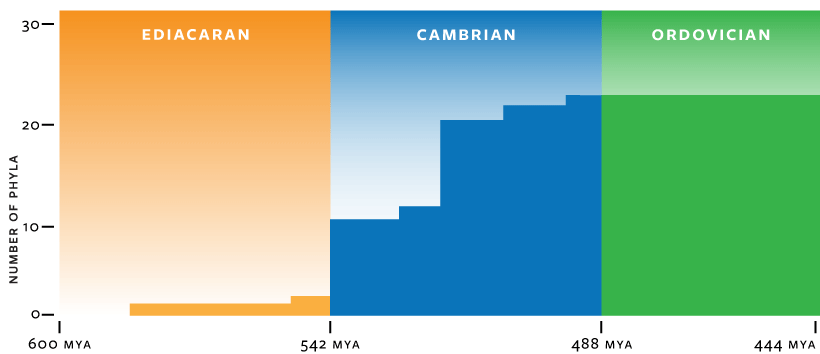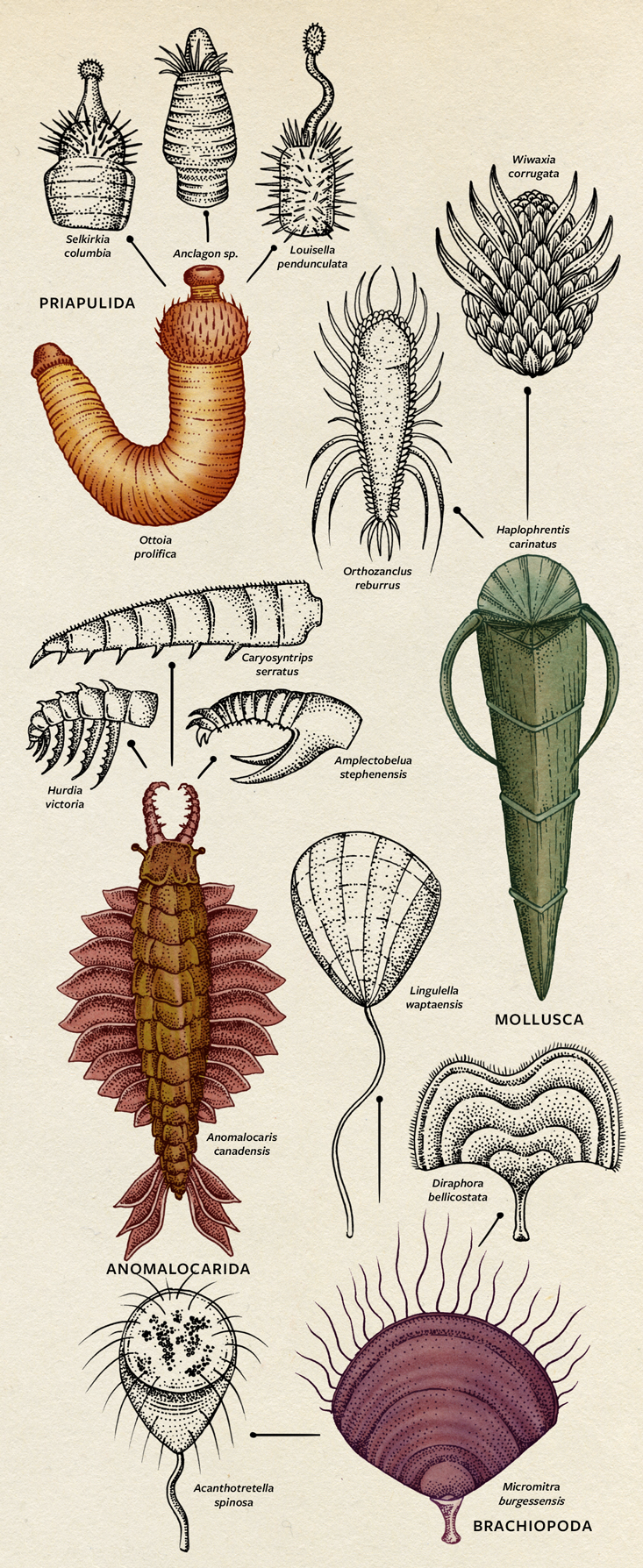Battles fought 542 million years before today helped fuel a blast that brought humans and most animals into existence. The great Cambrian Explosion was a period of unprecedented one-upmanship. Beastly claws crushed through thin skin, and soft-bodied creatures evolved shells shaped like scythes, sickles, and shields.
For about a billion years prior, the cells and genes that would later create animals were evolving in microscopic organisms who inhabited the oceans of Earth (see Deep Time). These essential molecular changes may only be inferred today because they’re not preserved in fossils. The earliest traces of animals, about 580 million years old, appear soft, with no sign of claws, teeth, limbs, or brains. Then, within 54 million years (a relative blink but still, 270 times the duration of humans’ existence thus far), most of the main animal groups around today originated. This rapid rate of increase in animal architectures has never since been repeated.

A simple species count does not do justice to the power of the Cambrian Explosion. Species have continuously formed over time. A new type of moth may have antennae that are furrier than its sisters; a new species of dinosaur may be distinguished by clawed wings and vicious front fangs. But a new phylum—a major branch on the tree of life, the upper-level ranking that separates an insect from a pterodactyl—is rarely born.
Most of today’s 30 to 40 animal phyla originated in the Cambrian, and have persisted through time with hundreds of variations on a theme (see Explosion). Where the Cambrian Explosion saw a proliferation of architectures (picture igloos, cabins, skyscrapers, suburban houses, and grass huts), the rest of time has mainly been about remodeling existing forms (add a Jacuzzi, a deck, or a tin roof). The explosion of animal phyla in the Cambrian includes the category, the chordates, to which humans, reptiles, sloths, and fish belong. Chordates are united by a central bundle of nerve fibers running down our backs, supported by a stiff rod.

Why did it take so long for the explosion to happen? After all, life arose 3.5 billion years ago, and the first eukaryotic cells (the kind within our bodies) occurred a billion and a half years later. Beneath the surface, a lot was probably going on: DNA had to work just right for organisms with multiple cells to evolve, and then enable a diversity of forms for natural selection to play with. In the Cambrian, “[animals] got large, and biomineralized, and they started doing stuff they never did before,” says Nick Butterfield, a paleontologist at the University of Cambridge in the United Kingdom. “Suddenly,” he says, “it just started to click.”
Certainly, the environment around the time of the Cambrian encouraged the explosion as well. Oxygen had accumulated in the oceans after extreme ice ages occurred between 800 and 550 million years ago. With plentiful oxygen, animals could grow large and absorb the air they needed to breathe through their skin. (Lungs evolved later in time.) Vast real estate was also available, after the glaciations killed off the soft creatures that predate the Cambrian. Finally, other changes in dissolved oceanic gases helped. Calcium levels increased, which made possible the skeletons and shells of Cambrian marine life.
However, had the conditions been right but life passive, we might not be alive today. As soon as moving animals with mouths, nerves, and guts formed, they began to eat other animals—and their prey reacted. So ensued a biological arms race like the offensive and defensive escalation that occurs between warring nations (see Radiation). As predators gobbled up smaller prey, vulnerable animals landed on various means of protection: thick shells, spikes, and sophisticated methods of hiding. Their aggressors followed suit with specialized ways to track specific prey. Claws to smash shells, for example, or keen eyes to spot camouflaged prey. As University of California, Berkeley paleontologist Charles Marshall says, “It was a whole suite of arms races” (see Underwater Combat).

As for why an explosion such as this hasn’t been repeated, one possibility is that most of the fundamental strategies for dealing with various interactions were discovered quickly, says Marshall, “and that’s that.” Another idea is that the number of combinations of genes acting together to produce novel animal characteristics have been exhausted. If these hypotheses are correct, the main limit is internal: The ruckus collapsed from within.

Brooke Borel is a journalist and author. She’s a contributing editor at Popular Science, and writes for The Atlantic, the Guardian, BuzzFeed News, FiveThirtyEight, and more. Her books are Infested: How The Bed Bug Infiltrated Our Bedrooms and Took Over the World and The Chicago Guide To Fact-Checking.
Additional Reading
Erwin, D.H. & Valentine, J.W. The Cambrian Explosion: The Construction of Animal Biodiversity Roberts and Company Publishers, Inc., Greenwood Village, Colorado (2013).
Marshall, C. Explaining of the Cambrian “Explosion” of Animals Annual Review of Earth and Planetary Sciences 34, 355–84 (2006).
“The Cambrian Explosion,” Royal Ontario Museum, Burgess Shale: http://www.burgess-shale.rom.on.ca/en/science/origin/04-cambrian-explosion.php






























